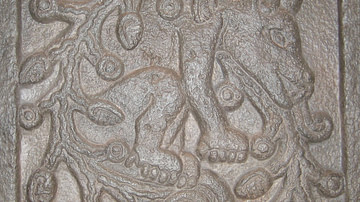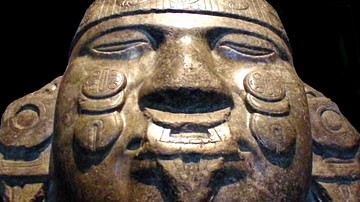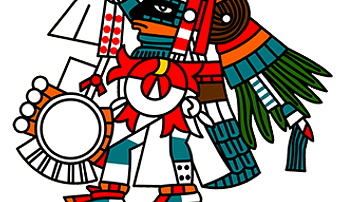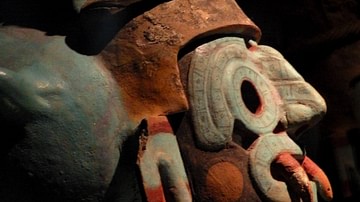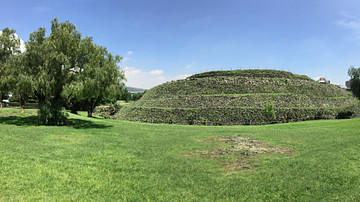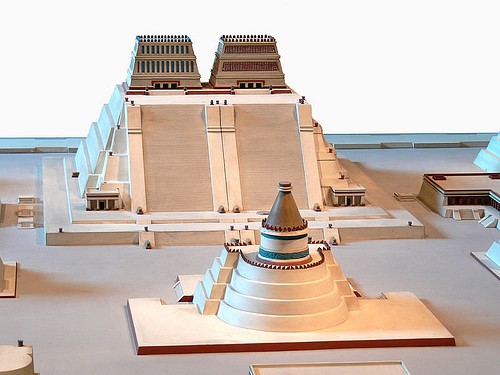
The Templo Mayor or Great Temple (called Hueteocalli by the Aztecs) dominated the central sacred precinct of the Aztec capital Tenochtitlan. Topped by twin temples dedicated to the war god Huitzilopochtli and the rain god Tlaloc it was a focal point of the Aztec religion and very centre of the Aztec world. It was also the scene of state occasions such as coronations and the place of countless human sacrifices where the blood of the victims was thought to feed and appease the two great gods to whom it was dedicated.
Construction
The Templo Mayor was first constructed in the reign of Itzcoatl (r. 1427-1440 CE), improved upon by his successor Motecuhzoma I (r. 1440-1469 CE), and again enlarged during the reign of Ahuitzotl (r. 1486-1502 CE). These rulers, and others, each employed the resources and labour given in tribute by neighbouring states in order to build a more impressive monument than their predecessors.
The location was chosen with purpose as the temple was a stone improvement on the original shrine the first settlers of Tenochtitlan had built in honour of Huitzilopochtli in the Aztec founding legends. As the temple grew over the years, offerings and precious goods were ritually buried within its ever-expanding layers. The pyramid was reached via a sacred Processional Way constructed along an east-west axis. The Pyramid was similarly built on an east-west axis so that when at the top of the stairway one would face the east and see both Mt. Tlaloc and, on the equinox, see the sunrise exactly between the two shrines on the upper platform. Located at the centre of Tenochtitlan the Templo Mayor was the religious and social heart of the Aztec empire.
Dimensions & Form
The Templo Mayor was the most important structure at the centre of a large sacred precinct measuring 365 m (1,200 ft) on each side and surrounded by a wall which, because of its snake relief carvings, was known as the coatepantli or 'Serpent Wall'. The precinct may have contained as many as 78 different structures but the Templo Mayor was by far the tallest and must have dominated the city skyline. The temple was actually a 60 m (180 ft) high pyramid platform with four tiers and two flights of steps on the western side leading to a summit with two twin temples or shrines, the whole structure being faced with lime plaster and brightly painted. The north (right) side shrine was dedicated to Tlaloc, the god of rain and the other, on the south (left) side, was dedicated to Huitzilopochtli, the god of war. Tlaloc was also associated with mountains and it is probable that the Templo Mayor was conceived as a literal architectural mountain in homage to this facet of the rain god, a man-made imitation of Tonacatepetl, Tlaloc's 'Mountain of Sustenance'. At the very same time, and with the typical Mesoamerican passion for duality, it was also a representation of Coatepetl, the sacred 'Serpent Mountain' where Huitzilopochtli vanquished the other gods.
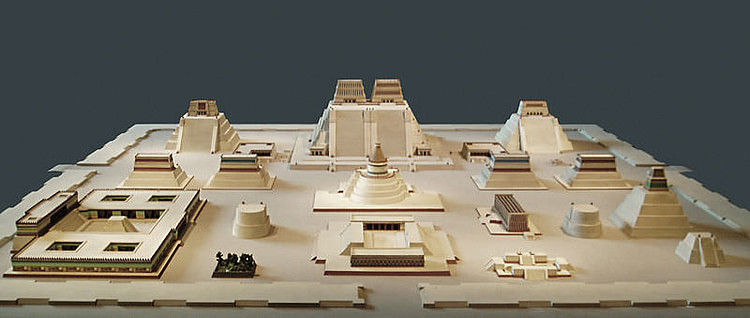
The temple on the north side, painted with blue stripes, was dedicated to Tlaloc and marked the summer solstice (symbolic of the wet season) whilst Huitzilopochtli's south-side shrine, painted red, marked the winter solstice (symbolic of the dry season and a time for warfare). Within each shrine was a wooden statue of the god. The monumental steps leading to Tlaloc's temple were painted blue and white, the former colour representing water, the element so strongly associated with the god. In contrast, the steps leading to Huitzilopochtli's temple were painted bright red to symbolise blood and war. Both flights carried sculptures of snake heads; those on Tlaloc's side had blinkers while those on Huitzilopochtli's were adorned with feathers.
Human Sacrifices
Tlaloc was seen as both a giver of essential rain in a frequently harsh environment but also as a destructive force when he sent storms, floods, and droughts. Double reason, then, for the Aztecs to do all they could to keep this fickle deity in a good mood. Huitzilopochtli was the supreme Aztec god and considered the god of the sun, war, gold, rulers, and he was patron of Tenochtitlan.
For the Aztecs the best way to gain favour with these two powerful gods was to honour them with a suitably impressive temple monument and to regularly offer sacrifices to satiate their lusty appetites and perpetuate the harmony between gods and humanity. Further, sacrifices were considered as due payment for the sacrifices the gods had themselves made when they created the world. These offerings could take the form of food, flowers, and precious goods (shells and coral, for example, have been excavated from Tlaloc's shrine) but also, at key times in the calendar especially, blood. The sacrifice of animals and non-fatal blood-letting amongst the priestly class were common practices but the Aztecs have now become infamous for their most dramatic and important choice of offering: human sacrifice.
A typical sacrifice involved the victim being stretched over a stone while a priest, armed with an obsidian knife, ripped out their heart and then decapitated and dismembered them. Following all that the corpse was flung down the steps of the pyramid to land at the base where a massive round stone depicted Coyolxauhqui, the goddess who was similarly treated by Huitzilopochtli in Aztec mythology after she had led a rebellion against the great god. Finally, the heads of victims were displayed on racks known as tzompantli which were set at the base of the pyramid.
Sacrificial victims were usually war captives but children were also sacrificed as their tears were considered a favourable link with the life-giving raindrops from Tlaloc. The priests who carried out this carnage, on occasion, ate the flesh of the victims, with the heart being the most prized, if it had not already been burned in offering to the gods. The Aztec ruler, privileged nobles, and those who had captured the victims in war also participated in this symbolic feast.
Major Ceremonies at the Templo Mayor
Sacrifices could also take place to commemorate important state events. One of the most infamous is the four-day butchering of captives when Ahuitzotl re-dedicated the temple and extended it even higher in order to celebrate his imperial triumphs in 1487 CE. Another important event was the New Fire Ceremony, held every 52 years - a complete solar cycle in the Aztec calendar - when the first flaming torch came from Mt. Huixachtlan and was used to light the sacred fire atop the Templo Mayor before being transferred to all subsidiary temples in the city.
The Templo Mayor was also a regular focal point during the celebrations of Huitzilopochtli's birthday in the ceremony of Panquetzalitzli in the month of the same name. Another important festival was held during the month of Toxcatl when an effigy of the god made from dough and dressed in his costume was paraded through the city and then eaten at the Templo Mayor. State funerals occurred at the site, notably the funeral cremation of three rulers: Axayacatl, Tizoc, and Ahuitzotl. Finally, coronations took place at the temple, notably that of the last true Aztec king Motecuhzoma Xocoyotzin, better known as Montezuma, in 1502 CE.
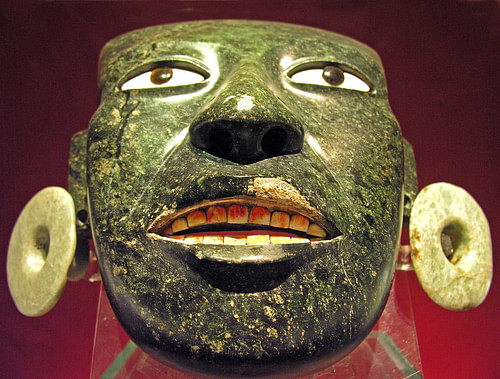
Later History & Excavation
The pyramid was razed following the Spanish Conquest - the Aztecs had used it as a rallying point and defended it vigorously - and a Christian cross had been placed on top of it. Then over the centuries it was gradually built over and disappeared beneath 19th century CE colonial buildings in downtown Mexico City. Never forgotten, the site was half-heartedly excavated in the early 20th century CE and then systematically from the late 1970s CE. It was then discovered that the pyramid was in fact a succession of pyramids each built over a smaller predecessor and even the original primitive platform, dated with the aid of a stone hieroglyph to 1390 CE, was discovered.
So too, many artefacts, purposely buried by the Aztecs, have been excavated at the site, and these include fine pottery, figurines, jade and mother-of-pearl jewellery, animal skeletons which include fish, a crocodile, two golden eagles and a jaguar, and prizes from earlier Mesoamerican civilizations such as one Olmec mask and another from Teotihuacan. Three of the larger finds related to the temple are the 3.5 metre (diameter) stone of Coyolxauhqui from the pyramid base, a chacmool sculpture (used to burn victim's hearts) from the shrine of Tlaloc, and a 12-ton rectangular monolith depicting the earth-goddess Tlaltecuhtli. The site continues to be excavated to the present day with regular new findings adding to the history of this greatest of Aztec monuments.
